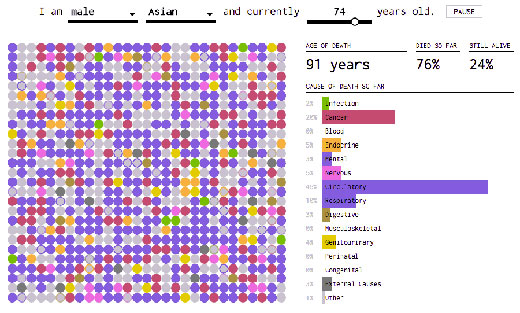(单词翻译:单击)
They say Jan. 18 — or Blue Monday — is the most depressing day of the year, but they're wrong. The most depressing day of the year is today, because you're about to find out how and when you're most likely to die.
人们总说“蓝色星期一”,即1月18号那一天,是一年中心情最阴郁的日子。错了。最郁闷的一天将是今天,因为今天你将发现自己很可能会怎么死、何时死。
Statistician Nathan Yau has created an interactive chart to determine, in his words, "how and when you will die, given your sex, race and age." Fun!
统计学家邱南森制作了一个互动图表,他称这个图表将“根据年龄、种族以及年龄不同,显示每个人在各个年纪将面临何种威胁生命的问题”。真神奇!

To create his chart, Yau used data from the CDC's Underlying Cause of Death Database, a rather bleak collection of US death statistics from 1999 to 2014. Using information obtained from Americans' death certificates, the database catalogs deaths based on age, race, gender, year and cause of death, among other metrics.
美国疾控中心收集了1999年至2014年期间国内死亡证明上的一些信息,并统计了其中关于美国人主要死因的系列数据,结果不容乐观。该数据库根据年龄、种族、性别、年份、死因及其他参数将死亡情况进行分类。
Once you enter your sex, race and age, the chart will kick into motion. For each year past your current age, it'll show you how likely you are to die of various common causes of death: infection, cancer, blood, endocrine, mental, nervous, circulatory, respiratory, digestive, musculoskeletal, genitourinary, perinatal, congenital and external causes.
只要你一输入自己的性别、种族和年龄,该图表就开始发生相应变化。对于你今后的每一年,它都将显示一组潜在的死因,如传染病、癌症、血液疾病、内分泌失调、精神疾病、神经疾病、循环系统疾病、呼吸疾病、消化疾病、肌骨失常、泌尿生殖疾病、围产期死亡、先天性疾病及其他外因。并且,随着年纪的改变,各死因概率会发生对应的变化。
For every year past your current age, the chart will also show you the likeliness of having died by that point.
图表中还会显示,你活到某一个年龄的概率有多大。
The main point, which is what you'd expect, is that mortality rate is much lower in the earlier years of life than in the older years. But, if you do die at a younger age, it's much more likely due to something external rather than a disease.
可以想见的是,相较于晚年,早年死亡率要低得多。但是,早年死亡的原因大多是外部事故,而非自身疾病。
You can also look at it the other way. Shift age to the older years, and let the simulations run. You're much more likely to die of a disease rather than something external. Shift past 80 years, and it's over 40% chance the cause will be circulatory, regardless of demographic group.
你也可以换个角度看这个问题。把年龄设定得大一些,然后让模拟器运转起来。随着人们慢慢变老,死因更有可能是自身疾病,而非外部因素。不管哪类人,活至八十,死于血液循环疾病的几率都超过40%。
I tried the chart out for myself, a 24-year-old white female. If I die two years from now, at 26, there's hardly any chance it'll be from health problems — and a very high likelihood it'll be from external causes.
我自己也尝试了一下这个图表。我按要求依次输入了自己的信息:女性,白种人,24岁。图表上显示着:两年后,也就是当我26岁的时候,我若是面临着死亡,基本上可以肯定不是因为我身体不好,而罪魁祸首很有可能是意外事故。
At 50 years old, there's a 95% chance I'll still be alive — that's still pretty good! If I do happen to die at 50, it'll most likely be from circulatory problems, cancer, infection or external causes.
图表显示我能活到50岁的几率高达95%,这简直太棒了!但如果我不幸50岁的时候死了,极大可能是死于血液循环疾病、癌症、传染病或意外事故。
Finally, here I am at 80. Now, there's only a 52% chance I'll still be alive. If I die, the most likely causes will be circulatory, cancer and endocrine.
最后,看一下八十岁的我是怎样的情况吧。果然,我活着的几率减半了,只有52%,主要的死因是血液循环疾病、癌症和内分泌失调。
Yau was surprised to see that circulatory problems — and not cancer — were such a prominent cause of death.
邱南森惊讶地发现,主要致死疾病竟然是血液循环疾病而非癌症。
"It seems like cancer would be the leading cause, just going off general news," he wrote. "This is certainly true up to a certain age, but get past that and your heart can only keep going for so long."
他写道:“根据各大新闻的报道,人们似乎一直认为癌症才是头号杀手。当人活到某个年纪,确实如此。但就算你过了这一关,你的心脏也只能再运转这么些年。”
想玩的复制此链接搜索:http://flowingdata.com/2016/01/19/how-you-will-die/


